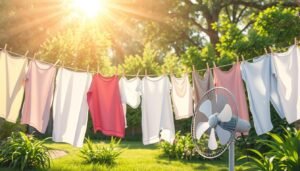That stubborn gray film on your surfaces isn’t just unattractive. It forms when minerals in water combine with residues.
This buildup creates an ideal environment for unwanted growth. Addressing it promptly protects your space and maintains hygiene.
Many commercial products contain harsh chemicals. Natural alternatives offer effective cleaning without these concerns.
Common household items like vinegar and baking soda work wonders. They’re cost-effective, safe, and environmentally friendly.
This guide covers preparation, removal methods, and prevention strategies. You’ll learn techniques for various materials and buildup levels.
Key Takeaways
- Soap scum forms from hard water minerals mixing with residues
- Prompt removal prevents mold and mildew development
- Natural solutions are effective and avoid harsh chemicals
- Common household ingredients can tackle most buildup
- Methods work on glass, tile, fiberglass, and stone surfaces
- Prevention strategies reduce future cleaning time
- These approaches are budget-friendly and eco-conscious
Understanding Soap Scum and Its Challenges
This insoluble film develops when water minerals interact with various residues in moist environments. Knowing its composition and behavior helps homeowners address it effectively using natural approaches.
What Exactly Is Soap Scum?
Hard water contains calcium and magnesium ions. These minerals react with fatty acids found in many cleansing products.
The chemical reaction creates a sticky, insoluble residue. This substance bonds strongly to various household surfaces.
Body oils and dirt particles often get trapped in this matrix. The combination forms a persistent film that resists simple rinsing.
Where Soap Scum Commonly Accumulates
High-moisture areas experience the most significant buildup. Glass enclosures and tiled walls collect substantial deposits.
Fixtures and fittings throughout wet spaces develop this film. Bathtubs, sinks, and faucets regularly accumulate the residue.
Even appliances like dishwashers can develop similar issues. The film appears wherever water and cleansing products combine.
Why Prompt Removal Is Essential
Delayed attention allows the film to harden and thicken. This makes subsequent removal much more challenging and time-consuming.
The porous nature of accumulated residue traps moisture. This creates ideal conditions for unwanted biological growth.
Persistent neglect can lead to surface deterioration. Some materials may require expensive repairs or replacement.
Regular maintenance preserves appearance and functionality. It also reduces long-term effort and resource expenditure.
Preparing for Natural Soap Scum Removal
Proper preparation sets the foundation for effective results. Having the right ingredients and tools ready makes the process smoother. This approach saves time and ensures safety for various materials.
Essential Natural Ingredients You’ll Need
White vinegar stands as a powerhouse for dissolving mineral deposits. Its acidity breaks down stubborn films without harsh chemicals.
Baking soda offers gentle abrasiveness for scrubbing. It works well on many surfaces when used properly.
Lemon juice provides natural cutting power and fresh scent. Hydrogen peroxide serves as an effective disinfectant for areas needing sanitation.
Borax tackles tough combinations of film and biological growth. Dish soap helps emulsify and lift residues from various materials.
Safety Considerations for Different Surfaces
Always check manufacturer guidelines before applying any solution. Special finishes like anti-fog coatings require specific care.
Avoid using abrasive baking soda on mirrors and fiberglass. These materials can scratch easily with rough scrubbing.
Certain metal finishes may react with acidic vinegar. Test any solution on a small, hidden area first.
Proper ventilation remains important during application. Open windows or use fans when working with concentrated solutions.
Gathering Your Cleaning Tools
Spray bottles allow for easy application of liquid solutions. They help distribute mixtures evenly across large areas.
Microfiber cloths provide streak-free drying and polishing. Their soft texture prevents damage to delicate materials.
Non-abrasive sponges offer safe scrubbing power. Soft brushes work well for textured surfaces and grout lines.
Old toothbrushes reach into tight tracks and corners. Squeegees help maintain surfaces after cleaning sessions.
Having these tools organized before starting improves efficiency. This preparation minimizes interruptions during the process.
Primary Natural Methods for Soap Scum Removal
Natural ingredients offer powerful solutions for tackling stubborn residue. These methods break down buildup without harsh chemicals.
Each approach works through different chemical properties. Understanding these helps you choose the right method.
The Vinegar and Baking Soda Power Combination
White vinegar dissolves mineral deposits effectively. Its acidity breaks bonds holding residue to surfaces.
Baking soda provides gentle scrubbing action. Together they create a fizzing reaction that lifts buildup.
For light deposits, spray vinegar and let sit 20 minutes. Sprinkle baking soda and scrub gently before rinsing.
Make a thick paste for heavier accumulation. Apply this mixture and wait 20 minutes before wiping clean.
This combination works on various surfaces safely. It’s one of the most effective ways to remove soap scum naturally.
Lemon Juice: A Fresh Approach to Cutting Through Scum
Lemon juice contains natural citric acid. This helps cut through stubborn films quickly.
Apply directly to problem areas or use as a spray. Let it work for 10-15 minutes before scrubbing.
The fresh scent leaves spaces smelling clean. It’s particularly good for cutting through oily residues.
Rinse thoroughly after scrubbing. This prevents any sticky leftover residue.
Hydrogen Peroxide for Stubborn Buildup and Disinfection
Hydrogen peroxide tackles tough combination problems. It works well against both residue and biological growth.
Combine with baking soda for extra cleaning power. Let the mixture fizz for 15-20 minutes before scrubbing.
This solution disinfects while removing stains. It’s excellent for addressing mold mildew issues.
Never mix hydrogen peroxide with vinegar. This combination can create harmful chemical reactions.
These ingredients are affordable and easily available. Experiment to find which works best for your situation.
Alternative Natural Solutions for Shower Cleaning and Bathroom Care
Expanding your natural cleaning arsenal with these specialized approaches addresses different levels of buildup effectively. Each method targets specific challenges while maintaining environmental safety.
Borax Paste for Tough Mold and Mildew Combinations
Borax stands out for tackling combined residue and biological growth. This mineral-based cleaner creates a powerful paste when mixed with water.
Apply the mixture directly to problem areas with visible staining. Allow it to work for at least twenty minutes before scrubbing gently.
This approach works particularly well on non-porous materials where other methods might struggle. Always test on a small area first to ensure surface compatibility.
Rinse thoroughly after treatment to remove all residue. The natural disinfecting properties help maintain a healthier environment.
Vinegar and Dish Soap Solution for Regular Maintenance
A simple combination of white vinegar and dish soap handles light accumulation beautifully. Mix these ingredients in a two-to-one ratio for optimal results.
Transfer the mixture to a spray bottle for easy application. Cover affected areas evenly and let sit for fifteen minutes.
Wipe clean using a microfiber cloth to avoid streaking. This gentle formula works well for weekly upkeep routines.
Regular use significantly reduces future intensive sessions by preventing heavy buildup. The solution cuts through light films without harsh chemicals.
Heat-Activated Natural Cleaners for Stubborn Deposits
Warming certain natural solutions enhances their cleaning power dramatically. Heat helps break down stubborn mineral deposits more effectively.
Combine equal parts white vinegar and dish soap in a microwave-safe bowl. Heat gently until warm but not boiling, then allow to cool slightly.
Apply the warmed solution to problem areas using appropriate tools. The enhanced formula cuts through tough accumulation more efficiently.
Always handle warmed mixtures with care to avoid burns. Test on a small, inconspicuous area before full application.
These methods provide comprehensive coverage for various maintenance needs. Incorporating them into regular routines keeps spaces looking their best naturally.
Specialized Techniques for Different Bathroom Surfaces
Each material in your wet space requires unique handling. Proper techniques preserve finishes while eliminating buildup effectively.
Understanding surface compatibility prevents accidental damage. This knowledge ensures long-lasting results without costly repairs.
Cleaning Glass Shower Doors Without Streaking
Combine equal parts white vinegar and dish soap in a spray bottle. Apply this mixture generously across the entire glass surface.
Allow the solution to work for twenty to thirty minutes. This dwell time breaks down mineral deposits thoroughly.
Rinse completely with warm water using a soft cloth. Immediately follow with a squeegee to prevent water spots.
For persistent streaks, create a baking soda paste with minimal water. Gently apply this mixture using circular motions.
Rinse immediately and dry with a microfiber cloth. This approach maintains crystal-clear transparency without harsh chemicals.
Safe Methods for Fiberglass Showers and Tubs
Weekly maintenance prevents heavy accumulation on these delicate surfaces. Create a paste using baking soda and vinegar.
Apply this non-abrasive mixture using a soft sponge. Gentle circular motions lift residue without scratching.
For stubborn stains, try a borax and lemon juice combination. This powerful yet natural solution tackles discoloration effectively.
Always rinse thoroughly after treatment. Avoid abrasive tools that could dull the glossy finish.
Natural Approaches for Tile, Grout, and Porcelain
The baking soda and vinegar paste works excellently on these materials. Apply it generously across tiles and grout lines.
For challenging buildup, use a wet pumice stone gently. Avoid this technique on enamel surfaces to prevent damage.
Scrub grout with an old toothbrush for precise cleaning. This reaches into tiny spaces that larger tools miss.
Rinse completely to remove all residue. Proper drying prevents moisture-related issues.
Metal Fixture Care Without Damage
Different metals require specific natural solutions. Chrome, brass, and bronze respond well to equal parts vinegar and water.
Stainless steel handles undiluted white vinegar effectively. Apply using a soft cloth and polish to a shine.
Oil-rubbed finishes need only water for routine maintenance. Harsh solutions could damage these delicate coatings.
Soak showerheads in vinegar to remove mineral deposits. This restores water flow and appearance naturally.
Always test methods on inconspicuous areas first. Thorough rinsing and drying prevent spots and maintain brilliance.
Preventing Soap Scum Buildup Naturally
Strategic prevention methods offer the most effective approach to maintaining pristine surfaces. Consistent routines minimize future maintenance while preserving material integrity.
These techniques work with natural principles rather than against them. They create sustainable results with minimal time investment.
Daily Maintenance Habits That Make a Difference
Simple routines performed consistently yield remarkable results. Wiping down wet areas after each use prevents residue formation.
Using a squeegee on glass and tile surfaces removes water droplets. This action significantly reduces mineral deposit accumulation.
Keeping a squeegee accessible encourages regular household participation. Quick wipes take seconds but save hours of deep cleaning time.
Proper ventilation dramatically reduces moisture-related issues. Running exhaust fans during and after use lowers humidity levels.
This environment discourages mold mildew development alongside other residues. Weekly light wiping maintains surfaces between thorough sessions.
Choosing the Right Soaps and Products
Product selection directly impacts residue formation rates. Liquid body washes create less film than traditional bar options.
These formulations contain fewer fatty acids and talc ingredients. They rinse cleaner without leaving stubborn deposits behind.
Castile soap offers an excellent natural alternative for daily use. Its plant-based formula minimizes mineral interaction issues.
Avoiding talc-based products reduces one major contributing factor. Quality selections maintain cleanliness while being gentle on materials.
This approach proves particularly beneficial for fiberglass and other delicate surfaces. The right choices prevent problems before they begin.
Water Quality Solutions for Long-Term Prevention
Addressing hard water issues provides comprehensive results. Mineral content directly influences residue formation rates.
Water softeners transform calcium and magnesium ions into harmless forms. This change prevents the chemical reactions that create stubborn films.
Filtered showerheads reduce mineral content entering the space. They offer an affordable solution for renters and homeowners alike.
These investments pay for themselves through reduced maintenance needs. They also extend the lifespan of fixtures and surfaces.
Regular filter changes maintain optimal performance over time. This proactive approach creates lasting protection against accumulation.
Implementing these strategies reduces deep cleaning frequency significantly. They preserve appearance while promoting healthier environments throughout the home.
Maintaining a Naturally Clean Bathroom Long-Term
Achieving permanent results demands integrating solutions into your lifestyle. Consistent daily habits prevent major accumulation between deeper sessions.
Quick wipes and proper product choices make a significant difference. Water quality management remains crucial for minimizing mineral issues.
Establish a simple schedule combining weekly light attention with monthly thorough care. Natural approaches preserve materials while protecting your environment.
Adapt these strategies to your specific needs and usage patterns. With regular attention, you’ll maintain a sparkling space efficiently.
These methods prove both effective and sustainable for long-term success. Your dedication to natural care yields lasting beauty and hygiene.



